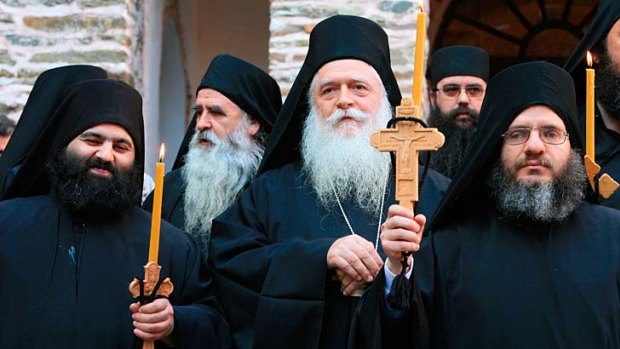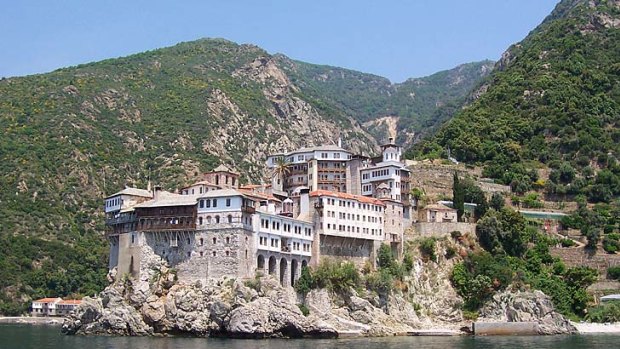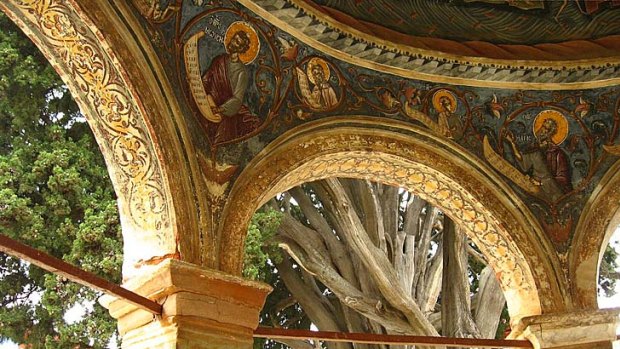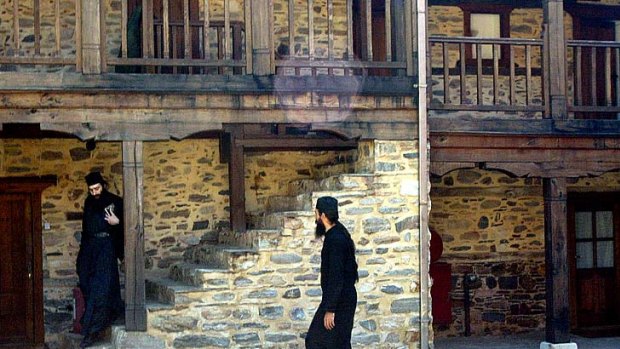
Chaps in black... monks gather at a monastery on Mount Athos.Credit: Alamy
Stuart Forster receives a pilgrim's welcome at Mount Athos in Greece, as he explores its monastic traditions.
Even the most ardent fans of Mount Athos have no qualms about saying this isn't a destination for everyone. Only men are permitted to visit the self-governing peninsula in northern Greece, which has long been a pilgrimage site for Orthodox Christians. An undulating 50-kilometre finger of land that pokes into the Aegean Sea, the peninsula is home to 20 monasteries and about 2500 monks.
Mount Athos was designated a World Heritage site in 1988. Its monastic tradition pre-dates the foundation of the oldest monastery, Great Lavra, in 963; hermits and monks are known to have sought spiritual fulfilment in austere cells built on the slopes of the 2033-metre mountain centuries earlier.

Grigoriou monastery, which is more than 1000 years old.Credit: Getty Images
According to Athonite legend, a storm drove ashore a boat carrying the Virgin Mary and St John the Evangelist as they travelled to visit Lazarus in Cyprus. The natural beauty of the area is said to have impressed Mary so profoundly she asked to be given the region around the mountain as her garden and inheritance.
The mountain was consecrated as the garden of the "Mother of God", then at some later point the rule banning women (known as the "Avaton") was introduced.
Any woman landing at Mount Athos today will be told she is trespassing and asked to leave. An ambiguously translated sign at the fenced-off land border - regularly patrolled and permanently closed - forbids "the entrance of women". Any decision to lift that restriction would have to be taken in the town of Karyes, the capital of the autonomous monastic state Agion Oros, meaning "Holy Mountain" in Greek.

Frescoes at Great Lavra monastery.
Visitors to Mount Athos need to follow a time-consuming administrative process which includes requesting a diamoneterion, or permit. Only 10 such permits are allocated to non-Orthodox visitors on any given day, with a maximum stay of three nights. Before being issued my diamoneterion, officials at the pilgrims' office in the town of Ouranoupoli had to meet me.
French author Maryse Choisy claimed she disguised herself as a man and spent time in the monasteries of Mount Athos, an experience she drew on while writing A Month Among the Men, first published in 1929. How, I wonder, could she have even acquired a diamoneterion? The permit has to be shown in order to board a ferry to Mount Athos from the ports of Ouranoupoli and Ierissos. Approaching by sea is the only way for pilgrims and visitors alike to enter, which helps create the illusion that Mount Athos is an island.
Women can take sightseeing cruises around the peninsula but are not allowed on to ferries.

Monks in one of the community's courtyards on Mount Athos.Credit: AFP
At the tiny port of Daphne I disembark and see monks and pilgrims milling about on the quay. The ferry brings the monastery provisions as well as people; goods are unloaded from ship to ute. I seek out Ignatius, a monk with no surname, who drives me to the Grand Lavra monastery. Despite being steeped in tradition, Mount Athos has seen some changes: mini-buses started running in 1997, about 17 years after the first sealed roads opened. Ignatius says that Mount Athos now has about 50 vehicles, mule transport having been phased out.
"If it hadn't been for motor vehicles we couldn't have maintained or repaired the monasteries," Ignatius says, embracing the arrival of the modern world for its practical advantages.
As with other monks here, Ignatius has no bank account or personal possessions. He wears an untrimmed beard, black prayer cap and a much-washed, long-sleeve, once-black body-length cassock.
I've never had a chance to speak frankly with an Orthodox monk and I'm intrigued to learn why Ignatius is driving rather than praying. If he's bothered by the prying, he doesn't show it. "The monastery is like a family, and every day I go out to earn money to bring home," he says. "When I'm awake I pray all of the time. I don't have a schedule; I can be talking but also praying. The mind is independent."
Ignatius says he spends seven hours a day in formal prayers and his eyes sparkle such that I feel I'm speaking with someone who's satisfied with his lot in life.
Great Lavra is surrounded by defensive walls and is entered through an imposing gate. The riches and relics of monasteries made them an attractive target for raiders during the Middle Ages so fortifications afforded significant protection. Even now the gate is locked at night.
I'm asked to show my diamoneterion and given the age-old pilgrim's welcome: a glass of water to help slake my thirst, a piece of sweet loukoumi cake for energy and a glass of raki, the aniseed-flavoured spirit that helps settle stomachs unaccustomed to local water. This hospitality, I'm told, is an obligation that helps develop friendships.
I'm free to explore the courtyard and find peeling, stylised frescoes of Orthodox saints in the alcoves. The detail and age suggest they could easily grace a gallery or museum. Murals in the monastery's church were painted by the Cretan artist Theophanes in 1535; a passing monk reminds me that I can look but must not photograph inside the church. I sense that despite their hospitality some monks still have concerns as to how this area is portrayed to the world.
Under the shade of a bamboo gazebo with a fantastic view of Mount Athos I meet with Epiphanios (sometimes known as Epiphanios of Mylopotamos), a monk embracing change. As we talk, the Aegean laps just metres away from the lowest slope of a carefully tended vineyard.
"Civilisation and the progress of life bring changes," says the 56-year-old Epiphanios, who came to Mount Athos in 1973. He has been instrumental in planting four hectares of vines and reintroducing wine production to the region. In order to do so he took a €180,000 ($228,500) loan from the National Bank of Greece. How business will develop, in light of the country's wider economic woes, hangs in the balance.
Epiphanios made his name as a chef, cooking for monks during festivals. "Many of the monks here live to about 90 years old," he says. "Their diet helps." As the author of The Cuisine of the Holy Mountain Athos, about the local diet based on fresh vegetables, herbs and fish, Epiphanios says monastic cuisine is directly related to Mediterranean cuisine. "Family recipes in Thessaloniki and Crete are similar to the recipes of Mount Athos," he says, before inviting me to the kitchen, where we chat as we chop vegetables.
"I'd like people to continue coming here and to understand Mount Athos for what it is." We eat and I feel blessed by the warmth of his hospitality.
FAST FACTS
Getting there
Qantas and Turkish Airlines fly from Sydney to Thessaloniki, via Singapore and Istanbul, from $2180. See qantas.com.au. Flights on Olympic Air from Sydney to Thessaloniki, via Abu Dhabi and Athens, cost from $3266. See olympicair.com.
Public KTEL buses run between Thessaloniki and Ouranoupolis (for west coast monasteries) and Ierissos (for east coast monasteries). Ferries from both ports take passengers to Mount Athos.
Mount Athos Pilgrim's Bureau (phone +30 2310 252578; email piligrimsbureau@c-lab.gr) has information about obtaining a diamonitirion. The permit is issued by the Ministry of Foreign Affairs, Directorate of Churches in Athens (phone 210 3626 894) or the Ministry of Northern Greece, Directorate of Civil Affairs at Diikitiriou Square, Thessaloniki (Phone 2310 270 092).
Staying there
Accommodation at monasteries must be requested in advance. See athosfriends.org/PilgrimsGuide/planning. The Eagles Palace at Ouranoupoli has rooms from €189 ($238) a night; see eaglespalace.gr.
More information
See inathos.gr/athos/en.
Sign up for the Traveller Deals newsletter
Get exclusive travel deals delivered straight to your inbox. Sign up now.